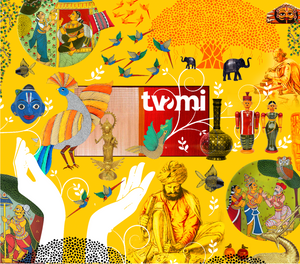Udayagiri Cutlery
Filters
-

 Sold out
Original price ₹160.00 - Original price ₹160.00Original price ₹160.00₹260.00₹260.00 - ₹260.00Current price ₹260.00| /
Sold out
Original price ₹160.00 - Original price ₹160.00Original price ₹160.00₹260.00₹260.00 - ₹260.00Current price ₹260.00| /Udayagiri Wooden Cutlery - Small Serving Spoon
Shaikh Zakeer Hussain
No reviewsArtistic and eco-friendly in equal measure, this small serving spoon comes from Udayagiri, Andhra Pradesh. The town is well-renowned for practicing...
View full detailsOriginal price ₹160.00 - Original price ₹160.00Original price ₹160.00₹260.00₹260.00 - ₹260.00Current price ₹260.00| /Sold out -

 Sold out
Original price ₹805.00 - Original price ₹805.00Original price ₹805.00₹905.00₹905.00 - ₹905.00Current price ₹905.00| /
Sold out
Original price ₹805.00 - Original price ₹805.00Original price ₹805.00₹905.00₹905.00 - ₹905.00Current price ₹905.00| /Udayagiri Wooden Cutlery - Serving Spoon and Fork Set
Shaikh Zakeer Hussain
No reviewsArtistic and eco-friendly in equal measure, this serving spoon and fork set comes from Udayagiri, Andhra Pradesh. The town is well-renowned for pra...
View full detailsOriginal price ₹805.00 - Original price ₹805.00Original price ₹805.00₹905.00₹905.00 - ₹905.00Current price ₹905.00| /Sold out
Udaygiri – the cutlery of Nawabs
Believed to have originated in the 14th century, this wood-carving craft is native to Udayagiri town located in Nellore district of Andhra Pradesh. The wooden spoons, forks, knives and bowls from Udayagiri are renowned for their intricate hand carved patterns. The craft always enjoyed royal patronage and its popularity surged in the 19th century. Artistic, aristocratic and utilitarian in equal measure, it is a fine example of how creativity can turn even the most common aspects of daily life into something exquisite. Rising awareness and appreciation of traditional arts and crafts has lent Udayagiri a fresh breath of life. The eco-friendly articles have become increasingly popular as house warming gifts and festive gifts around Diwali, as well as for self use by aesthetes.
History and origins of Udayagiri
The first documented history of the town dates back to the 14th century and was ruled by the Gajapatis of Odisha, at the time. Languja Gajapati, their Chieftan at the time, is credited with commissioning the construction of the iconic Udayagiri fort. Later, it became a part of the Vijayanagar Empire and subsequently, came under the rule of the Nawabs of Arcot who controlled the region till 1839. It was under the rule of the nawabs and jagirs that the wooden cutlery from Udayagiri gained widespread popularity. It was also the period when the cutlery’s patterns, motifs and carvings got their Persian influence. The craft was developed by skilled local artisans who shaped soft wood sourced from nearby forests, using mere hand tools, into beautiful cutlery and serve-ware.
Process behind making of Udayagiri cutlery
Central to the craft’s origin and sustenance is the forest land on Durgam Palli hills located nearby. The forest provides the supply of soft wood like nardi, deodari, bikki chakka, kaldi chakka, and palabarki. Of these, nardi and bikki chakka are relatively softer and hence are used for small cutlery pieces. Larger cutlery pieces and bowls are made using the deodari or kaldi chakka. Depending on the requirement, the artisans carefully select blocks of wood sourced from the forest. The blocks are stored in a dry area for several days before being soaked in water and redried. The entire exercise takes a few weeks, after which they are cut into smaller sizes, based on the product to be made.
A unique pre-carving practice involves winding the smaller blocks with a jute string, which is kept in place with a heavy stone on top of it. This removes any left over-moisture, and makes the wood softer and more suitable for carving. Once the jute threads are removed, marking is done on the blocks in the shape of the cutlery that would be made out of it. First the basic shape is carved out of the block with the help of a chisel. It has to be done very skilfully and with a deft hand as the soft wood can break easily. Thereafter, the artisans show their true creativity and talent. Use of simple tools, like a chisel, filer, drill and nails, they carve out beautiful intricate patterns in the wooden article. Amini, khajuri, kangura and dargah ki jaali are some of the popular patterns. Finishing of the small and delicate pieces is done with files, while a paper finishing is used for the larger pieces.
Artisans and aspirations
Udayagiri Cutlery making has largely been a generational craft with the skillset passed on from one generation to the other. However, over the years while some families have moved away from the craft, others have made efforts to teach the skills to more people and help these artisans earn a sustainable living through the craft. What used to be a male-dominated vocation in the era gone-by, is now practiced by several women. tvami works with artisans at the grass roots to help them in their endeavour to take the craft’s popularity to greater heights and expand their reach beyond borders.






